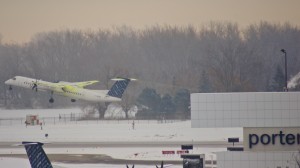
A Porter Airlines airplane sheds de-icing fluid
(yellow green on wings)
into Toronto’s harbour as it takes off on Christmas Day
Photo by Dennis Bryant
A proper de-icing facility is impossible at Toronto Island airport. A recently-released draft Master Plan for the Island Airport says tight physical constraints at Toronto’s Island Airport make provision of a proper de-icing facility impossible.
Here’s what the Plan states:
The runoff of effluent from the de-icing operation is captured at catch basins located strategically on the apron and directed to below-grade storage facilities. From there, the runoff is released to the municipal sanitary system….Given the tight physical constraints of the airport, particularly in the vicinity of the terminal building, there is no opportunity to provide a centralized de-icing facility [at page 15].
Lester B. Pearson Airport has a centralized de icing facility where the toxic fluid is captured and recycled .
When will this— and the other breaches— stop?
This is another reason why expansion of the Island Airport is a bad idea: there is no room for proper de-icing facility. Instead, the Port Authority dumps it into the sewer, in breach of the Tripartite Agreement.
De-icing fluid used at the Island Airport is, according to TPA CEO Geoff Wilson, “collected through a series of catch basins on the main apron which is separate from the storm water drainage sewers and discharge areas.
From the catch basin, the drainage flows to the Island’s sanitary treatment facility…”
Dumping de-icing fluid into the sanitary sewer system is contrary to the Tripartite Agreement :
“The Lessee shall not discharge, cause or permit to be discharged or howsoever to pass into the sewer systems, storm drains or surface drainage facilities at the demised premises, if any, or elsewhere any noxious, contaminated or poisonous substances…”
De-icing fluid is commonly composed of ethylene glycol and toxic additives. The US Environment Protection Agency states :
Aircraft deicing/anti-icing fluids (ADFs) typically contain water, glycols, and additives. The toxicity exhibited by ADFs is due in part to the presence of glycols (which typically make up approximately 45% to 65% of the total fluid by weight when applied), but is also due to the additives contained in the fluids. Although additives comprise a small percentage of ADFs (e.g., less than 2%), they may be responsible for a disproportionate share of the toxicity of ADFs.
… The identity of the actual chemicals used as additives is not known because the ADF manufacturers claim this information confidential.
Whether a proper de icing facility is provided or not, de icing fluid on an aircraft will be shed by it as it takes off. The presence of the Island Airport in the midst of Toronto’s waterfront means these chemicals are shed into our harbour.
CommunityAIR wrote to Porter’s CEO Robert Deluce about de icing fluid in 2010:
Sent: March 9, 2010 11:35 AM
To: ‘robert.deluce@flyporter.com’
Subject: Yet another breach of the Tripartite Agreement
In the recent CITY-TV story, your Brad Cicero is quoted as saying:
“As far as de icing goes, that is all done in areas that have full containment so there is definitely no runoff on those locations,” Porter Airlines spokesman Brad Cicero said.
What happens is that the de icing fluid is collected and then pumped into the City’s sanitary sewage system. This is contrary to the Tripartite Agreement that states, in paragraph 20:
“The Lessee shall not discharge, cause or permit to be discharged or howsoever to pass into the sewer systems, storm drains or surface drainage facilities at the demised premises, if any, or elsewhere any noxious, contaminated or poisonous substances…”
Bob – your spokesman misled the reporter – dumping de icing fluid into the sewer breaches the Tripartite Agreement. There’s nothing acceptable about that.
When will this – and the other breaches – stop?
Mr. Deluce did not respond.
 TheBulletin.ca Journal of Downtown Toronto
TheBulletin.ca Journal of Downtown Toronto

